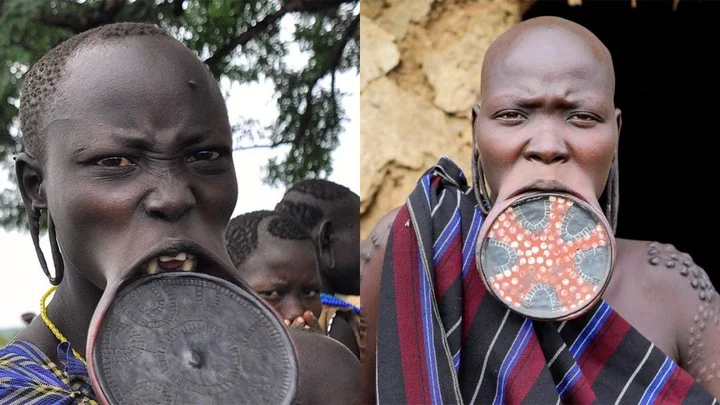
The Mursi Tribe, residing in the Omo Valley of Ethiopia, has been the subject of fascination and mystery for many.
Known for their distinctive customs and appearance, they have piqued the interest of anthropologists, photographers, and travelers.
One of the most intriguing aspects of the Mursi Tribe is their use of lip plates.
Mursi women insert large, decorative plates into their lower lips, which can grow up to 15 centimeters in diameter. The exact origin and purpose of this tradition remain mysterious. Some suggest it may have begun as a form of protection against slave raiders, while others believe it's a sign of beauty and identity.
The Mursi are also known for their intricate body scarification, with patterns etched into their skin, adding to the enigma surrounding their cultural practices. Their isolated lifestyle in the Omo Valley, with minimal contact with the outside world, contributes to the mystery that shrouds their way of life.
In recent years, increased tourism and outside influence have raised questions about the preservation of their traditions and the impact on their culture.
The mystery of the Mursi Tribe lies in their unique customs, the significance of their practices, and their resilience in maintaining their cultural identity in the face of modernization.

The Mursi Tribe's mystery deepens when you consider their complex social structure.
They live in extended family units called "Dala," led by a male elder known as the "Bula." These clans are semi-nomadic, moving with their livestock in search of water and grazing land. The Mursi's subsistence relies on cattle, which they consider a symbol of wealth and status, further contributing to the enigmatic nature of their culture.
Their remote location in the Omo Valley, with limited access to education and healthcare, adds to the challenges of understanding their way of life. Anthropologists and researchers continue to study the Mursi Tribe to unravel the mysteries surrounding their customs, language, and traditions, and to document their unique cultural heritage before it potentially fades away due to outside influences and modernization.

However, it's essential to approach the Mursi Tribe with respect for their privacy and traditions. The mystery surrounding their culture is a testament to the rich diversity of human societies and the importance of preserving and respecting indigenous cultures around the world.
As outsiders gain more access to the Mursi Tribe's territory through tourism and other means, there is growing concern about the impact on their way of life. The increased interaction with the outside world brings both opportunities and challenges.
The Mursi Tribe's story is a reminder of the ongoing struggle many indigenous communities face in preserving their traditions and cultural heritage in an increasingly globalized world. It is a compelling example of the need for cultural sensitivity and sustainable development when interacting with isolated communities like the Mursi.
In recent years, there has been a growing awareness and effort to protect and document the cultures of indigenous communities like the Mursi Tribe. International organizations, anthropologists, and even some governments are working together to promote cultural preservation and respect for these unique societies.
Education and cultural exchange programs have been initiated to create a deeper understanding of the Mursi Tribe and their way of life. This exchange of knowledge can be mutually beneficial, fostering appreciation for their culture and helping outsiders understand the significance of their customs and traditions.
Moreover, responsible tourism practices have been encouraged to minimize negative impacts on the Mursi and their environment. This includes supporting local initiatives, respecting their privacy, and not imposing outside values on their way of life. Tourists are often guided by experienced local hosts who facilitate respectful interactions and minimize harm.
The mystery of the Mursi Tribe remains an ongoing and evolving story, as the world grapples with the complexities of cultural preservation, development, and indigenous rights. The hope is that through careful and thoughtful engagement, the Mursi and similar communities can maintain their unique traditions while benefiting from the advantages of a globalized world.
The Mursi Tribe in Ethiopia embodies a captivating mystery in their unique customs and way of life. Their lip plates, scarification, and semi-nomadic existence continue to intrigue the world. As increased contact with the outside world poses both opportunities and challenges, it's crucial to approach their culture with respect and sensitivity.
By respecting their customs and traditions and approaching their culture with sensitivity, we can help ensure that the mystery and beauty of the Mursi Tribe endure for generations to come. We hope you've enjoyed this journey into the heart of the Mursi culture, and we encourage you to explore and learn more about the world's diverse and unique communities.
Watch video below:


















Comments